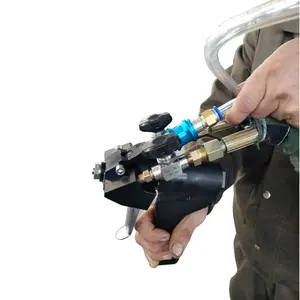(431 products available)























































































 Ready to Ship
Ready to Ship





























































































A purging kit is a specialized tool used in various industries, including manufacturing and printing, to remove residual materials or contaminants from equipment or systems before or during the production process. Purging kits are designed to enhance efficiency, reduce material waste, and ensure product quality by minimizing cross-contamination and maintaining the integrity of the primary materials or components being processed.
There are various types of purging kits:
Purging Kit Size:
Purging kits come in different sizes. The size of the purging kit is determined by the size of the purge valve on the gas cylinder. The size is specified using inches or millimeters. Common sizes include 1 inch (25.4 mm), 1.5 inches (38.1 mm), and 2 inches (50.8 mm).
Connection Type:
Purging kits have different connection types depending on the gas type and system in use. Common connection types include threaded, flanged, and quick-disconnect fittings.
Material:
Purging kits are constructed with different types of materials. The materials used are selected based on the type of gas being used and the application. Common materials include stainless steel, brass, and carbon steel.
Purge Flow Rate:
The flow rate at which the gas is emitted during the purging process is referred to as the purge flow rate. The flow rate is specified in liters per minute (LPM) or cubic meters per hour (CMH). Typical purge flow rates range from 10-100 LPM (0.35-3.5 CMH).
Purge Pressure:
The pressure of the gas in the purging kit during the purging process is referred to as the purge pressure. The purge pressure is specified in pounds per square inch (psi) or bar. Common purge pressures range from 50-200 psi (3.5-14 bar).
Safety Features:
Purging kits may include various safety features to ensure safe operation and prevent accidents. These safety features include pressure relief valves, burst discs, and safety interlocks.
It is important to observe the following purging kit maintenance requirements:
There are several factors that need to be considered when choosing a purging kit. They include:
Size and capacity
When it comes to choosing a purging kit for a specific application, size and capacity are important factors to consider. The right purging kit should be able to fit in the required size of the pipes and ducts. This will ensure that the purging kit can create a seal and facilitate the effective removal of unwanted substances. Additionally, the purging kit should have the capacity to hold the volume of the gas or liquid being purged. This will prevent interruptions during the purging process.
Material
The purging kit is made from different materials for different applications. Buyers should consider the material of the purging kit and whether it is suitable for the intended application. For example, purging kits made from stainless steel are durable and corrosion resistant, making them suitable for various applications. On the other hand, nylon purging kits are ideal for applications that require lightweight and non-metallic solutions.
Type of purging kit
There are various types of purging kits with different features. Buyers should select the purging kit that is suitable for the intended application. For example, buyers looking for a purging kit for plastic welding should go for a plastic welding purging kit. This is because the plastic welding purging kit is designed to provide an excellent purge prior to and during the welding process.
Quality
Quality is an important factor to consider when choosing a purging kit. Buyers should choose purging kits from reputable suppliers since they offer quality products. This is because quality purging kits provide consistent performance and durability. This helps buyers to save money in the long run since they will not incur costs of purchasing frequent replacements.
Application
Buyers should consider the specific application when choosing a purging kit. Different purging kits are designed for different applications. For example, a gas pipeline purging kit is used to remove air or moisture from the pipelines before the gas flows.
Replacing a vehicle purging kit can be a straightforward process, it depends on the purging kit in question. Car owners should ensure they have the right tools for the job, including:
To replace a purging kit, follow the following steps:
Q: How often should a purging kit be used?
A: The frequency of using a purging kit depends on several factors, including the type of material being processed, the color changes being made, and the production schedule. In general, it can be used whenever there's a significant shift in color or material to minimize waste and ensure product consistency.
Q: Is a purging kit reusable?
A: The reusability of a purging kit can vary based on its components. Some purging compounds are designed for multiple uses before disposal, while others may degrade or become contaminated after a single use. It's essential to follow the manufacturer's guidelines for each specific purging kit component.
Q: Can anyone use a purging kit, or is specialized training required?
A: While basic knowledge of its use is typically sufficient, specialized training can be beneficial. Understanding the proper techniques, safety measures, and best practices for using a purging kit can help optimize its effectiveness and minimize risks.
Q: What are the safety considerations when using a purging kit?
A: Safety considerations include ensuring proper ventilation when using purging compounds, adhering to material safety data sheets (MSDS) guidelines, and using appropriate personal protective equipment (PPE). Additionally, training users on handling and using purging kit components safely is essential.